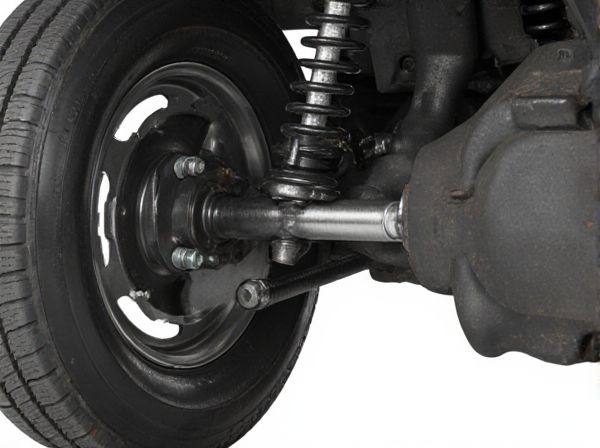
Photo illustration: Independent Axle vs Beam Axle
Independent axles allow each wheel to move independently, improving ride comfort and handling on rough terrain by reducing unsprung weight. Beam axles, also known as solid axles, connect wheels rigidly, providing greater durability and strength, which is ideal for heavy loads and off-road conditions. Your choice depends on whether you prioritize smooth ride quality or robust load-bearing capability.
Table of Comparison
| Feature | Independent Axle | Beam Axle |
|---|---|---|
| Design | Each wheel moves independently, improving ride comfort and handling. | Rigid beam connects both wheels, offering durability and simplicity. |
| Ride Quality | Better absorption of road irregularities, smoother ride. | Less flexible, transmits shocks across wheels. |
| Handling | Superior cornering and stability on uneven terrain. | Lower handling performance, especially on rough roads. |
| Durability | More complex, potential for higher maintenance costs. | Robust, low maintenance, ideal for heavy loads. |
| Cost | Higher manufacturing and repair costs. | Economical and cost-effective design. |
| Application | Common in passenger cars, SUVs focused on comfort. | Used in trucks, off-road vehicles, and utility vehicles. |
Introduction to Axle Systems
Independent axle systems allow each wheel to move independently, improving ride comfort and handling by reducing unsprung weight and enhancing traction on uneven terrain. Beam axles, also known as solid axles, connect the wheels with a single rigid beam, offering durability and strength, making them ideal for heavy-duty vehicles and off-road applications. The choice between independent and beam axles depends on factors like vehicle purpose, load capacity, and terrain requirements.
What is an Independent Axle?
An independent axle refers to a suspension system where each wheel on the same axle moves independently of the other, improving ride comfort and handling by allowing better road contact and reducing unsprung weight. Unlike beam axles that connect wheels rigidly, independent axles use components like control arms, ball joints, and struts to enable separate wheel movement. This design enhances vehicle stability, especially on uneven terrain, and is commonly found in modern passenger cars and off-road vehicles.
What is a Beam Axle?
A beam axle, also known as a solid axle, is a single rigid shaft connecting the wheels on opposite sides of a vehicle, allowing them to move together as a unit. This design offers durability and simplicity, making it common in heavy-duty trucks and off-road vehicles due to its ability to withstand rough terrain and heavy loads. Unlike independent axles, beam axles provide less ride comfort and handling precision because both wheels respond simultaneously to road irregularities.
Key Differences Between Independent and Beam Axles
Independent axles allow each wheel to move independently, providing improved ride comfort and handling over rough terrain through better wheel articulation. Beam axles connect wheels via a solid, rigid beam, resulting in a simpler design with increased durability and load-carrying capacity, ideal for heavy-duty applications. Key differences include ride quality, with independent axles offering superior comfort, and structural design, where beam axles provide enhanced strength and reduced maintenance costs.
Ride Comfort Comparison
Independent axle suspension offers superior ride comfort compared to beam axle systems by allowing each wheel to move independently, reducing vibrations and road shock transmitted to the vehicle body. Beam axles, with their rigid connection between wheels, tend to transfer more impact and uneven surface forces across the axle, resulting in a rougher ride. This key difference makes independent axles preferred for passenger cars and off-road vehicles requiring smoother handling and better traction.
Handling and Stability Analysis
Independent axle suspensions provide superior handling and stability by allowing each wheel to react individually to road conditions, reducing unsprung weight and improving tire contact with the road surface. Beam axles, characterized by a solid, rigid connection between wheels, offer durability but can compromise handling due to less responsive wheel movement and increased unsprung mass. For performance-focused vehicles, independent axles enhance cornering precision and ride comfort, while beam axles are preferred in heavy-duty applications where load-bearing capacity and simplicity outweigh advanced handling characteristics.
Durability and Maintenance Considerations
Independent axles offer enhanced durability in rough terrain by allowing each wheel to move independently, reducing stress on suspension components and minimizing wear. Beam axles are simpler in design, which typically results in lower maintenance costs and easier repairs due to fewer moving parts. However, beam axles may experience increased wear under heavy loads or uneven surfaces, potentially requiring more frequent maintenance to sustain durability.
Cost Implications and Affordability
Independent axles typically incur higher initial costs due to complex components and advanced suspension technology, resulting in increased manufacturing and maintenance expenses. Beam axles offer a more affordable alternative with simpler design and lower production costs, making them cost-effective for heavy-duty and budget-conscious vehicles. The choice between independent and beam axles significantly impacts the overall vehicle affordability, balancing upfront investment against long-term service costs.
Best Applications: Independent vs Beam Axle
Independent axles offer superior ride comfort and handling, making them ideal for passenger cars and light trucks used on paved roads and uneven terrain. Beam axles provide greater durability and load-bearing capacity, which suits heavy-duty vehicles, off-road trucks, and commercial applications requiring robust performance. Selecting between independent and beam axles depends on priorities such as ride quality for daily driving or strength and simplicity for heavy loads and rough environments.
Conclusion: Choosing the Right Axle for Your Needs
Selecting the appropriate axle depends on vehicle purpose and driving conditions; independent axles offer superior ride comfort and handling for passenger vehicles, while beam axles provide durability and load-bearing capacity suited to off-road and heavy-duty trucks. Independent suspension systems reduce unsprung weight and improve traction on uneven terrain, whereas beam axles deliver consistent ground clearance and simpler maintenance. Evaluating factors like vehicle weight, terrain, and intended use ensures optimal performance and longevity for your specific application.
 caratoz.com
caratoz.com